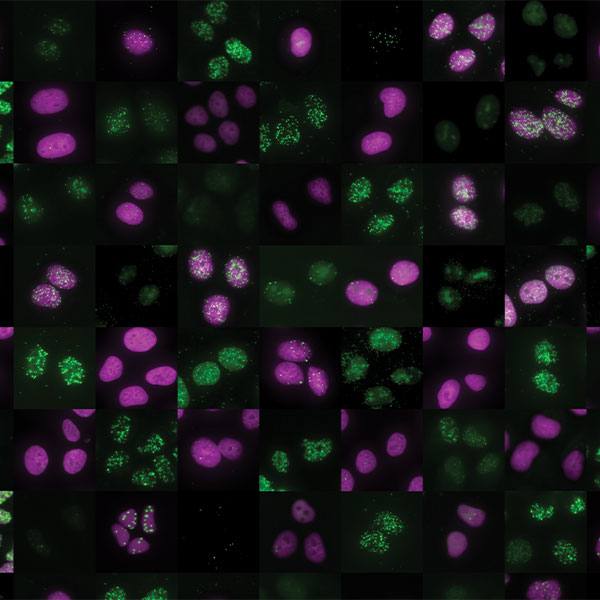-
Gene fusion discovery in ultrarare tumor highlights potential therapeutic target

A scientific investigation led by a team of researchers from Mayo Clinic's Center for Individualized Medicine reveals that an ultrarare cancer called epithelioid trophoblastic tumor (ETT), which can develop in the uterus after conception, recurrently exhibits an abnormal fusion of two genes. This fusion creates an unusual protein that triggers aggressive cell growth — the driver of cancer.

The findings, which were published in PLOS One, shed light on a potential diagnostic and therapeutic pathway for patients who have this rare cancer. The study also emphasizes the possibility of discovering hidden biomarkers and actionable therapeutic targets in other cancer types.
"Every cancer is unique, and if we can find individual markers in an exceedingly rare tumor and drive our research toward new clinical developments, it shows that as a research community, we can uncover hidden potential targets in other cancers," says Gavin Oliver, a Mayo Clinic principal bioinformatician who studies novel applications of omics techniques in genetic and genomic disease.
Gene fusion: A hidden enemy
Oliver, the lead author of the study, along with his team of researchers and pathologists, first identified the abnormal gene fusion in one U.S. case of an epithelioid trophoblastic tumor, which is part of a group of gestational trophoblastic disease that involves abnormal growth of cells inside a woman's uterus. Epithelioid trophoblastic tumors affect 1 in 500,000 pregnancies. They are poorly characterized and lack clear-cut markers.
"Targeted treatment options for ETT remain elusive," Oliver says. "ETT can appear many years after conception and can be extremely aggressive."
The team found that this unusual fusion occurred between the LPCAT1 and TERT genes. The fusion created an abnormal protein ― LPCAT1-TERT ― which caused accelerated cell growth. Oliver says that when cells multiply unchecked, it often leads to cancer.
"We were further able to show that this fusion was caused by a deletion of part of the genome that usually separates the LPCAT1 and TERT genes, and that it had occurred early in the development of the tumor," Oliver explains. "The TERT gene is a well-known cancer driver."
Worldwide search for exceedingly rare tumor cases
Convinced that his fusion discovery in one rare tumor was too important to be a one-off finding, Oliver and his team began a yearslong, worldwide search for more epithelioid trophoblastic tumor cases to prove their hypothesis further.
Among the researchers was Eric Klee, Ph.D., associate professor of Biomedical Informatics with the Center for Individualized Medicine and senior author of the study. Dr. Klee emphasizes that the team had identified multiple epithelioid trophoblastic tumor samples from major U.S. institutions, but those samples were too degraded to test.
"The rarity of the tumor and the natural tendency of archival material to degrade were huge obstacles to completion," Dr. Klee says.
The team’s rigorous investigation led them to Maternity Hospital in Kuwait, where they found an epithelioid trophoblastic tumor sample that carried the same fusion.
"Finding the fusion in that second ETT sample and subsequently proving its effects on cell growth was surprising, despite it being the basis of our scientific hypothesis," Oliver says. "This recurrence in our rare tumor and the proof it affects cell growth has potential diagnostic and therapeutic relevance that will hopefully fuel new research in this area."
Of tens of thousands of cancers that have been analyzed around the world, only a minute number of cases have been observed for similar fusions, according to Oliver. Oliver is hoping other researchers around the world will begin to routinely profile suspected epithelioid trophoblastic tumors for this fusion to advance understanding and save lives.
The Mayo study began in 2013 as part of an effort to provide the latest in genomics-based technologies to patients with advanced, treatment-resistant cancers or rare cancers with no standard of care.
"Genomic profiling of rare or advanced treatment refractory cancers is important because they are frequently aggressive and lack standard therapeutic options, but may be amenable to treatment with repurposed existing or novel treatments," Dr. Klee explains. "We can reveal a tumor's susceptibility to these treatments by identifying the precise genomic changes in the tumor."
The Mayo researchers remain focused on investigating rare cancers and looking for significant observations about the development and chain of events that lead to other common cancers and diseases.







